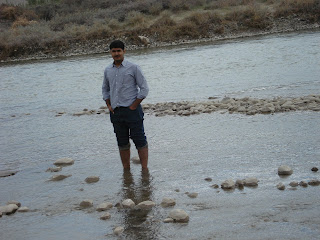16 May 07
Next stop was on the banks of River Sindhu (Indus), the spot is known as Sindhu Darshan, the place was built by the BJP government to hold their annual convention. Now it’s a picnic spot and a venue for the annual Leh festival. We had our lunch which we were carrying along.
Second day we started at 0940 hours for Hemis Monastery on the Leh-Manali highway. We had to deviate from the main highway to reach Hemis Monastery which is on another mountain. We came across a small Hydro-Electrical Power plant over the River Indus (Sindhu). The Hemis Monastery (Gompa) is 40 Kms from Leh; Hemis is one of the richest, biggest and most famous gompa in Ladakh. Built in 1630, it belongs to the Red sect. Its popularity stems from the major annual festival held during summer in honor of their Guru Padma Sambhava's birth anniversary, every 12 years the thanka with his photograph is displayed - the largest in the world. The monastery houses silver chortens studded with precious and semi precious stones, an impressive library of Tibetan style books, large number of thankas, various images of Buddha and frescoes including the famous "Wheel of Life".
(Hemis Monastery)
On our way back we visited Thiksey monastery where we saw a three storey high statue of Lord Buddha. The Thiksey Monastery is about 20 kms from Leh; Thiksey is an imposing monastery and one of the finest examples of Ladakhi architecture. The 12 storey monastery complex contains numerous stupas, statues, thankas, wall paintings, swords and a large pillar engraved with the Buddha's teachings. The main prayer hall has 15 meters high with seated Buddha figure.
( Thiksay Monastery)
After this we visited the Shey monastery. The Shey Monastery, until the 16th century was the royal residence. The Kings of Leh were supposed to be born in the monasteries. This Palace Monastery has the largest statue of Maitreya Buddha (Buddha to come) in Ladakh. Erected in the mid 17th century, worked out of gold and gilded copper sheets with blue hair, it stands 17.5 meters high.
All the monasteries are on top of small hills and one has to climb up. We then visited the Shey palace, the capital of ancient Leh. The palace is nearly in ruins but it is once again on a hill top which is usual for a palace or a Fort.
Next stop was on the banks of River Sindhu (Indus), the spot is known as Sindhu Darshan, the place was built by the BJP government to hold their annual convention. Now it’s a picnic spot and a venue for the annual Leh festival. We had our lunch which we were carrying along.
The next stop was Kali temple for which had to come back to Leh, as this is located next to Leh Airfield. The temple through known as Kali Temple but it is not really Kali Devi but, Mahakal Temple dedicated to Buddhist Goddess Vajrabhairava. The shrine houses Vajrabhairava and her terrifying face is unveiled only at the annual festival in January. The hill on which this temple is located comes in the way for the aircraft taking off from Leh airfield and the pilots are required to immediately clear off this hill which is very difficult also due to light air and requires extra precision and skill. It is said that two times they thought of blasting the hill but both times there was an air crash at the site. Now they have given up the idea.
A little below the temple is the Spituk Monastery. Spituk is 8 kms from Leh, standing majestically on top of a hillock overlooking the Indus Valley. Spituk Gompa is from the yellow sect. It houses a collection of ancient masks, antique arms, icons and numerous thankas. Both are over looking the Air Force Station Leh. This Air-strip is used for Civil Flights also.
The last Monastery for the day was a Japanese Gompa which is also known as Shanti Stupa, a relatively new Gompa, just about 15 years old, as compared to others which are 400-500 years old except Alchi and Likir Monastery.
The last Monastery for the day was a Japanese Gompa which is also known as Shanti Stupa, a relatively new Gompa, just about 15 years old, as compared to others which are 400-500 years old except Alchi and Likir Monastery.
(The town entrance-Leh)
Finally, we called it a day after taking a round of Leh Market.











No comments:
Post a Comment